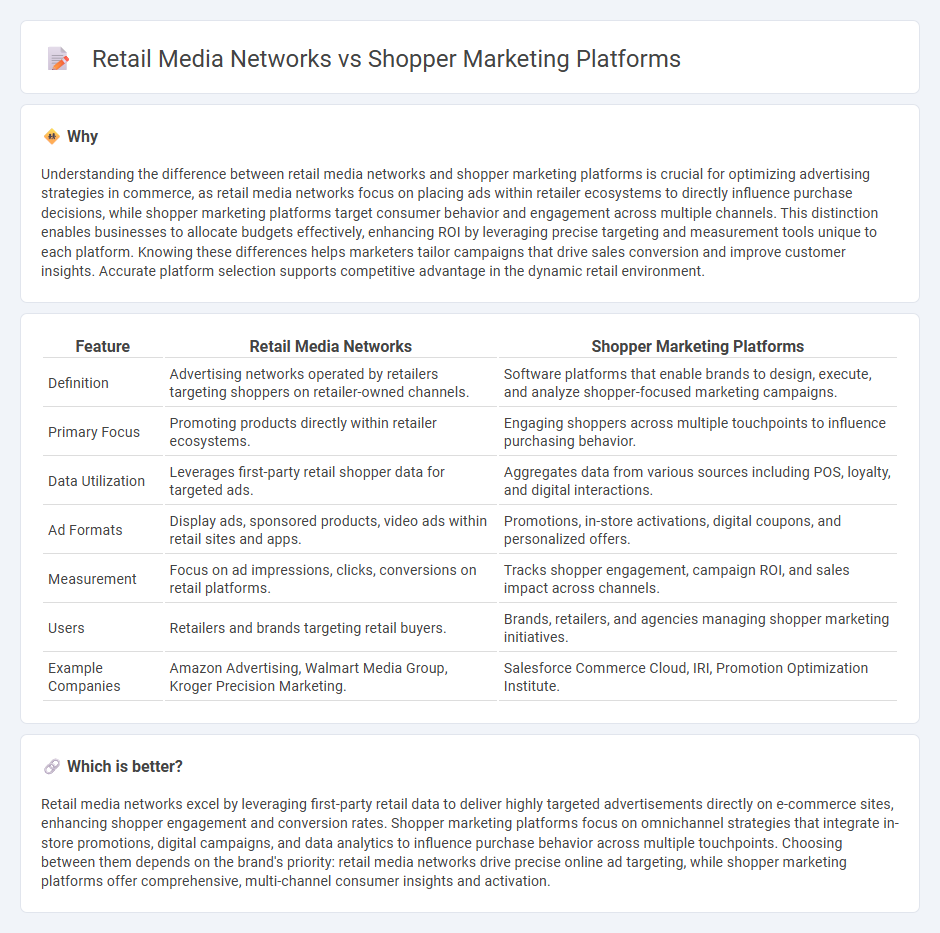
Retail media networks leverage first-party retail data to deliver targeted advertisements directly on e-commerce and retail sites, driving higher consumer engagement and purchase intent. Shopper marketing platforms focus on orchestrating promotional campaigns across multiple digital and in-store channels to influence consumer behavior throughout the purchase journey. Discover how combining these strategies can maximize marketing ROI and enhance customer experience.
Why it is important
Understanding the difference between retail media networks and shopper marketing platforms is crucial for optimizing advertising strategies in commerce, as retail media networks focus on placing ads within retailer ecosystems to directly influence purchase decisions, while shopper marketing platforms target consumer behavior and engagement across multiple channels. This distinction enables businesses to allocate budgets effectively, enhancing ROI by leveraging precise targeting and measurement tools unique to each platform. Knowing these differences helps marketers tailor campaigns that drive sales conversion and improve customer insights. Accurate platform selection supports competitive advantage in the dynamic retail environment.
Comparison Table
| Feature | Retail Media Networks | Shopper Marketing Platforms |
|---|---|---|
| Definition | Advertising networks operated by retailers targeting shoppers on retailer-owned channels. | Software platforms that enable brands to design, execute, and analyze shopper-focused marketing campaigns. |
| Primary Focus | Promoting products directly within retailer ecosystems. | Engaging shoppers across multiple touchpoints to influence purchasing behavior. |
| Data Utilization | Leverages first-party retail shopper data for targeted ads. | Aggregates data from various sources including POS, loyalty, and digital interactions. |
| Ad Formats | Display ads, sponsored products, video ads within retail sites and apps. | Promotions, in-store activations, digital coupons, and personalized offers. |
| Measurement | Focus on ad impressions, clicks, conversions on retail platforms. | Tracks shopper engagement, campaign ROI, and sales impact across channels. |
| Users | Retailers and brands targeting retail buyers. | Brands, retailers, and agencies managing shopper marketing initiatives. |
| Example Companies | Amazon Advertising, Walmart Media Group, Kroger Precision Marketing. | Salesforce Commerce Cloud, IRI, Promotion Optimization Institute. |
Which is better?
Retail media networks excel by leveraging first-party retail data to deliver highly targeted advertisements directly on e-commerce sites, enhancing shopper engagement and conversion rates. Shopper marketing platforms focus on omnichannel strategies that integrate in-store promotions, digital campaigns, and data analytics to influence purchase behavior across multiple touchpoints. Choosing between them depends on the brand's priority: retail media networks drive precise online ad targeting, while shopper marketing platforms offer comprehensive, multi-channel consumer insights and activation.
Connection
Retail media networks leverage shopper marketing platforms to deliver targeted advertisements and personalized promotions directly within e-commerce environments. By integrating shopper behavior data and purchase intent signals, these platforms enable retailers to optimize ad placements and improve customer engagement. This connection enhances the effectiveness of marketing campaigns, driving higher conversion rates and increased sales revenue.
Key Terms
Data Integration
Shopper marketing platforms leverage extensive data integration to unify consumer behavior insights across multiple touchpoints, enabling personalized marketing strategies that drive higher engagement and conversion rates. Retail media networks focus on integrating point-of-sale and first-party retail data to deliver targeted advertising within the retailer's ecosystem, optimizing ad spend and improving ROI. Explore the distinct data integration approaches and their impact on marketing effectiveness to make informed decisions for your brand.
Audience Targeting
Shopper marketing platforms leverage detailed in-store behavior data and purchase history to create highly personalized audience segments, driving point-of-sale engagement and conversions. Retail media networks utilize vast first-party retail data combined with shopper demographics and browsing patterns to target audiences across digital and physical retail channels for enhanced ad relevancy. Explore how these approaches optimize audience targeting for better marketing ROI and shopper engagement.
Omnichannel Activation
Shopper marketing platforms enable brands to engage consumers through personalized promotions and in-store activations, leveraging data from multiple touchpoints to enhance the shopping experience. Retail media networks capitalize on retailer-owned digital properties, offering targeted advertising solutions that integrate seamlessly across online and offline channels for omnichannel activation. Explore how integrating these strategies can maximize consumer reach and drive sales growth.
Source and External Links
Shopper Marketing | Platform and solution - Doohlabs - Shopper marketing platforms enable targeted in-store digital retail media campaigns, automating multimedia advertisements based on product SKUs for scalable and dynamic shopper engagement.
Top Shopper Marketing Agencies to Boost Your Retail Sales - Leading shopper marketing agencies offer platforms and services incorporating data-driven insights, omnichannel strategies, and retail partnership activations to drive shopper conversion both in physical stores and e-commerce.
Retail Media Network: Reach and engage shoppers - Retail media networks are digital advertising platforms where brands connect directly with shoppers, leveraging omnichannel shopper data and turnkey marketing tools to optimize retail media campaigns.
 dowidth.com
dowidth.com